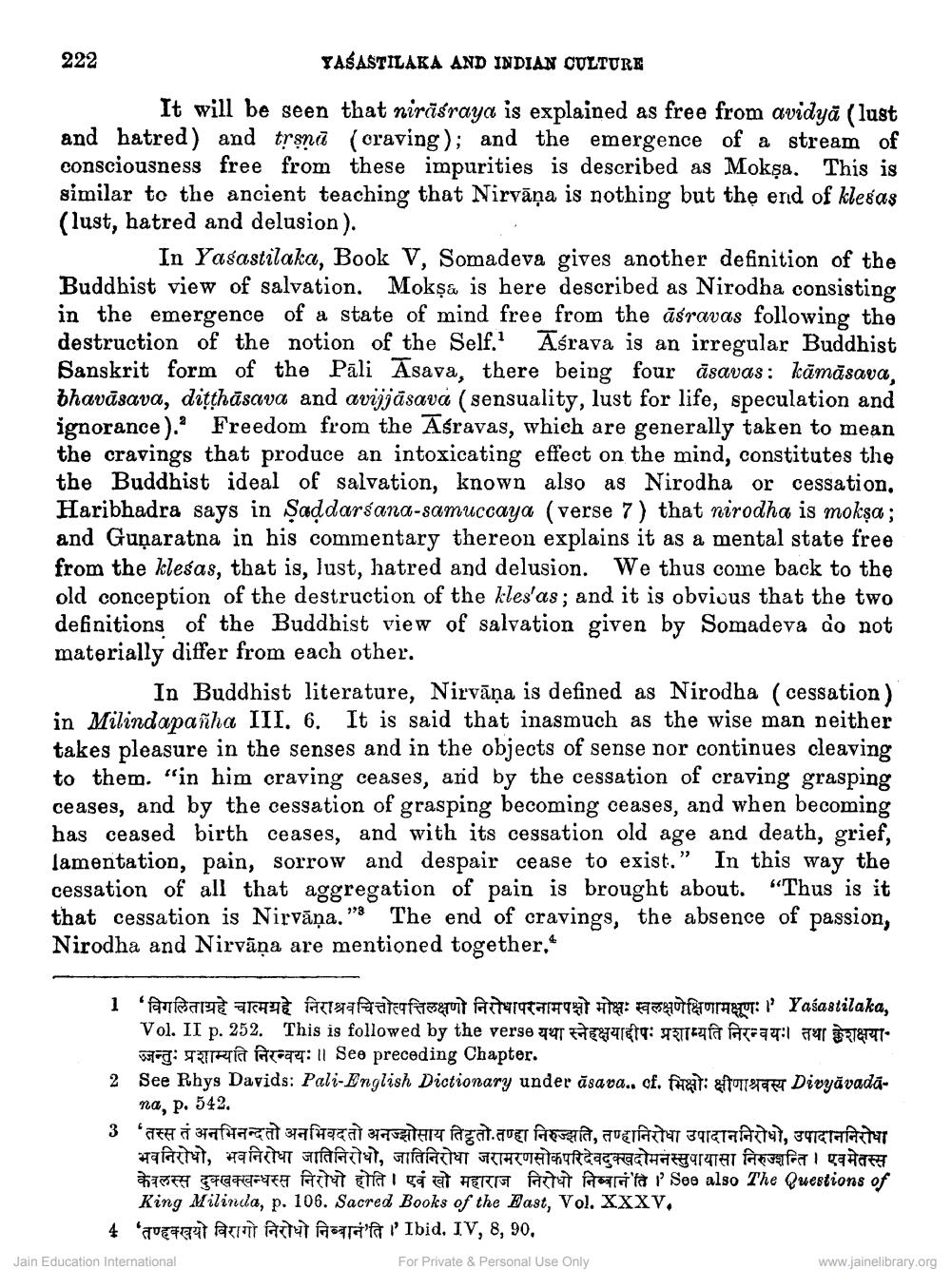________________
222
YASASTILAKA AND INDIAN CULTURE
It will be seen that niräsraya is explained as free from avidyā (lust and hatred) and trsna (craving); and the emergence of a stream of consciousness free from these impurities is described as Mokşa. This is similar to the ancient teaching that Nirvāṇa is nothing but the end of klesas (lust, hatred and delusion).
In Yasastilaka, Book V, Somadeva gives another definition of the Buddhist view of salvation. Mokşa is here described as Nirodha consisting in the emergence of a state of mind free from the āšravas following the destruction of the notion of the Self. Aśrava is an irregular Buddhist Ganskrit form of the Pāli Asava, there being four āsavas : kamāsava, bhavāsava, ditthāsava and avijjāsava (sensuality, lust for life, speculation and ignorance)." Freedom from the Aśravas, which are generally taken to mean the cravings that produce an intoxicating effect on the mind, constitutes the the Buddhist ideal of salvation, known also as Nirodha or cessation, Haribhadra says in Saddarsana-samuccaya (verse 7) that nirodha is mokșa ; and Gunaratna in his commentary thereon explains it as a men from the klesas, that is, lust, hatred and delusion. We thus come back to the old conception of the destruction of the kles'as; and it is obvious that the two definitions of the Buddhist view of salvation given by Somadeva do not materially differ from each other.
In Buddhist literature, Nirvāṇa is defined as Nirodha (cessation) in Milindapañha III. 6. It is said that inasmuch as the wise man neither takes pleasure in the senses and in the objects of sense nor continues cleaving to them. "in him craving ceases, and by the cessation of craving grasping ceases, and by the cessation of grasping becoming ceases, and when becoming has ceased birth ceases, and with its cessation old age and death, grief, lamentation, pain, sorrow and despair cease to exist." In this way the cessation of all that aggregation of pain is brought about. "Thus is it that cessation is Nirvāņa." The end of cravings, the absence of passion, Nirodha and Nirvāṇa are mentioned together,
1 'Padam KH Artsafastarf Gut Altereta 189: F OTOTAUT: /' Yaśastilaka,
Vol. II p. 252. This is followed by the verse Ta CHIETT: Tufa Artzaz:1 Ferrara
ज्जन्तुः प्रशाम्यति निरन्वयः॥ See preceding Chapter. 2 See Rhys Davids: Pali-English Dictionary under ăsava.. cf. fat: toiterary Divyāvadā
na, p. 542. 3 'तस्स तं अनभिनन्दतो अनभिवदतो अनज्झोसाय तितो.तण्हा निरुज्झति, तण्हानिरोधा उपादाननिरोधो, उपादाननिरोधा
भवनिरोधो, भवनिरोधा जातिनिरोधो, जातिनिरोधा जरामरणसोकपरिदेवदुक्खदोमनस्सुपायासा निरुज्शन्ति । एवमेतस्स 2777TEFTAM Chai gj ET HERE A Paritat i See also The Questions of
King Milinda, p. 106. Sacred Books of the East, Vol. XXXV.
4 MIATT ATT A R I' Ibid. IV, 8, 90. Jain Education International For Private & Personal Use Only
www.jainelibrary.org




